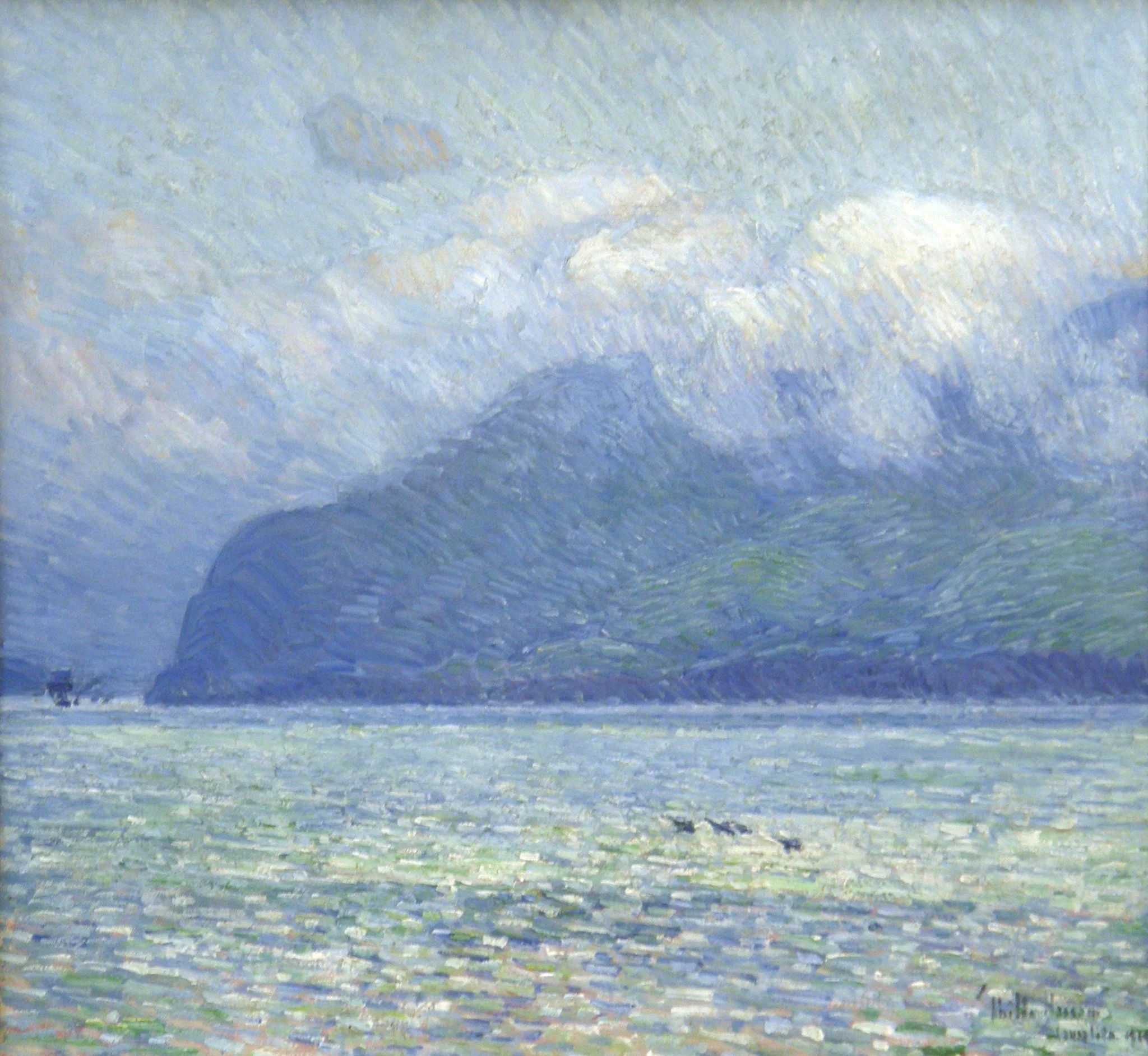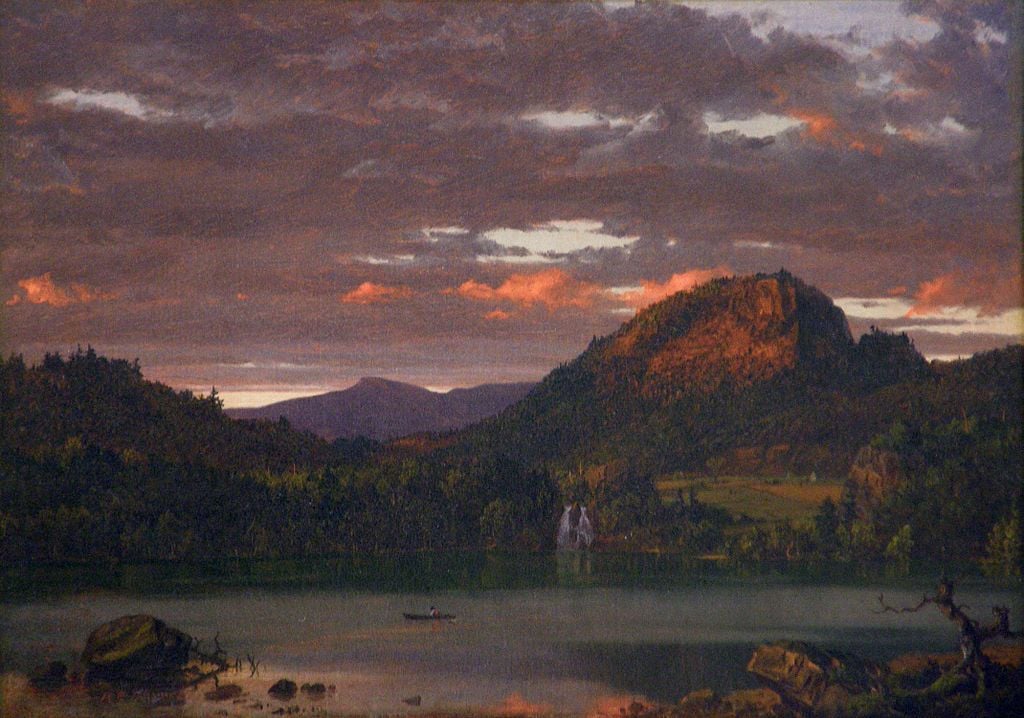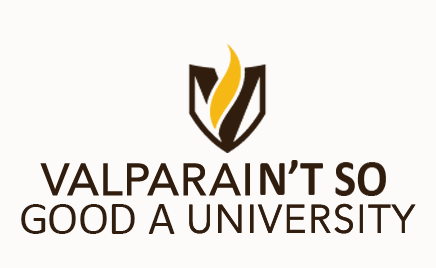"Conservative"?
« previous post | next post »
Matthew Erskine, "The Meaning of Conservative: Lessons from the Valparaiso University Dispute", Forbes 7/25/2024:
Valparaiso University is seeking to sell three valuable paintings, including a Georgia O'Keeffe, to fund renovations for freshman dormitories. The university argues that two of the paintings, purchased with funds from a 1953 donation by Percy Sloan, do not meet the donor's stipulation for "conservative" art. The donation specified that the funds be used to acquire "conservative" American art, which the university claims does not include modernist works like O'Keeffe's "Rust Red Hills" and Childe Hassam's "The Silver Veil and the Golden Gate."
Here are images of the three paintings, starting with Georgia O'Keefe's Rust Red Hills:
Childe Hassam's The Silver Veil and the Golden Gate:
And Frederic Church's Mountain Landscape:
The "not conservative" argument has been challenged, as the Forbes article goes on to note:
The University's decision has sparked significant controversy and mixed reactions from various stakeholders, including students, faculty, art historians, and the broader community. Critics argue that using the art collection as a financial resource undermines the university's cultural and educational mission. Gretchen Buggeln, a professor of art history, called the move "completely beyond the pale" and "unethical". Student activists have also voiced their disapproval, organized protests and are calling for alternative solutions. Richard Brauer, the museum's founding director, and Philipp Brockington, a retired professor, have filed a lawsuit to block the sale. They argue that the sale violates the terms of the original donation and the university's mission. The university has moved the paintings to a secure location pending the outcome of legal proceedings .
The Administration justifies the decision to sell the paintings as a necessary step to address declining enrollment and financial challenges. The proceeds from the sale are intended to fund much-needed renovations to freshman dormitories, which are seen as critical to attracting new students and improving campus life. The legal arguments revolve around the interpretation of "conservative” art, and that the paintings in question do not meet the donor's stipulations for "conservative" art. They claim that the modernist styles of the O'Keeffe and Hassam paintings do not align with the original intent of the donation, which specified acquiring "conservative" American art, which originally was concentrated in 19th century Hudson River landscapes. […]
The Indiana attorney general's office has not objected to the sale, and the decision now rests with Judge Michael Fish of Porter County Superior Court. The judge's interpretation of what constitutes "conservative" art will be crucial in determining whether the sale can proceed.
A possible problem for that argument is that (according to Wikipedia) Frederic Church "was a central figure in the Hudson River School of American landscape painters.'
According to Art Daily ("Valparaiso University closes museum and moves ahead with selling from the collection", 8/2/1014)
Valparaiso University has closed its Brauer Museum of Art and dismissed the director, Jonathan Canning, as part of an administrative restructuring announced late last week to address the tuition-dependent school’s falling enrollment and mounting operating deficit. The move surprised the local community as it comes just weeks after the museum opened America the Beautiful, its summer exhibition of Impressionist paintings drawn from the permanent collection. It also comes as the University moves ahead with its plan to sell the museum’s three most valuable paintings to fund renovations of freshman dormitories. […]
The museum’s former director, Richard Brauer, and former VU law professor and museum donor Philipp Brockington delayed the sale by filing suit against the university. They claimed it would violate the terms of the original gift agreement between Percy H. Sloan and VU. Sloan donated the Church landscape and established an acquisition fund with which Richard Brauer bought the Hassam and O’Keeffe in the early 1960s. Ultimately, the Court denied Brauer and Brockington standing. Indiana State Attorney General Todd Rokita stepped in to review the case, but recently opted not to oppose a sale. […]
In its May petition to Porter County Superior Court, the University claims that the three paintings have become too valuable for it to keep them safe. The petition cites an example of European environmentalists throwing paint at the Mona Lisa. VU estimates that security upgrades would cost between \$50,000 and \$100,000, and professional guards, as opposed to students, would add an additional \$150,000 to the museum’s annual staffing costs. It also argues storage fees at the undisclosed secure location, to which the paintings were transferred last Fall, are wasteful given its financial predicament. […]
VU also argues that the Hassam and O’Keeffe paintings should not have been bought with Sloan’s funds because of a stipulation that they be used to acquire only “conservative” paintings. Claiming that Richard Brauer first broke these terms, VU appeals to be released from all other restrictions, especially the requirement that revenue from sold paintings be deposited into the Sloan Purchase Fund. In response, Brauer has appealed to be heard by the Court, asserting that the University has misinterpreted his actions and overlooked the fact that Sloan’s executor, given full discretionary authority under the gift agreement, authorized both purchases.
Whether the judge engages in the art historical debate, he must determine if the enlargement of the student body, attracted by upgraded dormitories, cleaves closely enough to Sloan’s stated desire to educate students in the appreciation of art to allow the sale. As part of the dormitory renovations, the university will construct a gallery in which freshmen can examine examples of “conservative” art from the Sloan Collection.
In related news, "Valparaiso University considers cutting academic programs", NWI Times 3/4/2024 :
Valparaiso University is considering cutting nearly 30 undergraduate and graduateprograms due to low student enrollment, according to a memo sent to faculty members Friday.
The academic programs being considered for possible discontinuance include a number ofscience and medical studies, some foreign language majors, theology, music and cybersecurity,among other subject areas.
"We have too many majors, minors and graduate programs for the number of students andfaculty we have," Eric Johnson, the university's provost and executive vice president foracademic affairs, said in the memo.
And according to Justin Weinberg, "Valparaiso to Eliminate Philosophy Program", Daily Nous 7/30/2024:
Students at Valparaiso University will no longer be able to choose philosophy as a major or minor, according to a plan announced by the school’s president, José Padilla. […]
The philosophy programs at Valparaiso are currently housed in the Philosophy and Theology Department.
Meanwhile, according to the Chicago Tribune, “over the next year, the faculty and the provost’s office will develop a new major and required courses in the field of religion.”
The university says that “the freedom to pursue truth wherever it leads is at the heart of Valpo’s sense of community” and that “the university aims to foster in its students a lifelong commitment to this search for truth, encouraging the development of a sense of personal vocation as well as the intellectual and professional skills needed to pursue it.” How that aim is better achieved by the elimination of the very programs of study dedicated to it is unclear.
The Daily Nous article reproduces a visual-textual pun on the university's logo:
This is not as drastic or as sudden as what happened to the University of the Arts in Philadelphia, but it's another straw in the higher-education wind…




TonyG said,
August 2, 2024 @ 6:48 am
Two things:
(i) If they sell the paintings on the gounds that they are not conservative enough, surely the only ethical thing to do with the money raised is to buy paintings that _are_ conservative?
(ii) Being an ignorant furriner, I was half-way through the article before I suspected that perhaps Valparaiso University was not in Chile. A heads-up would have been nice!
Yuval said,
August 2, 2024 @ 9:31 am
Second on TonyG's second point.
Philip Taylor said,
August 2, 2024 @ 10:16 am
"This is not as drastic or as sudden as what happened to the University of the Arts in Philadelphia, but it's another straw in the higher-education wind…" — cf. https://www.cambridge.org/core/journals/international-journal-of-cultural-property/article/abs/case-of-thomas-holloways-picture-collection/0B97F9D4795C6096619C0EF998A80BE3
J.W. Brewer said,
August 2, 2024 @ 10:20 am
To be clear, it does not sound like Valpo (as we "insiders" call the university in question to show off our insiderness) is claiming that the Frederic Church painting, which was donated to them by the fellow who had set forth the "conservative" restriction, is not-conservative – they are trying to justify the sale of that one solely on other grounds.
As to the other two, the nugget that the purchases of them were contemporaneously known about and approved or at least acquiesced in by the executor of Sloan's estate, with the implication they wouldn't have been bought if the executor had objected to their lack of conservatism, seems like a bad fact for the university's position.
I'm guessing this is the same Percy H. Sloan (1867-1950) responsible for the Percy H. Sloan Collection of Photographs at the Newberry Library in Chicago. The Newberry is a few blocks from where I lived once upon a time and google maps tells me it's a 58 mile drive away from the Valpo campus.
J.W. Brewer said,
August 2, 2024 @ 10:28 am
The cynical view that this is all motivated by immediate financial concerns rather than a sincere institutional commitment to "conservative" anything might be further bolstered by noting that the university recently changed the name of its sports teams from the "Crusaders" (presumably originally motivated at least in part by the institution's affiliation with various Lutheran denominations) to the "Beacons." (The football team hasn't had a winning season since 2017, at least if you put an asterisk next to their 4-2 record in the shortened and pandemic-distorted 2020 season.)
J.W. Brewer said,
August 2, 2024 @ 11:09 am
One last point for now. As one of the linked pieces points out, what is or isn't "conservative" (whether in art or otherwise) varies depending on historical context. It's not a deictic word, exactly, but something maybe loosely akin to that. The donation is said to have been made in 1953, although if it's true that the donor died in 1950 it was presumably a bequest in his will that took a few years for the estate to actually pay out to the university. But in both 1950 and 1953, arguably the most famous new "unconservative" American painter was Jackson Pollock. In that context, as contrasted with Pollock's new style, Hassam's paintings at least (maybe not O'Keefe's quite so much?) look a lot closer to the "conservative" Hudson River School baseline than would have been the case back when Hassam had begun his career.
Gregory Kusnick said,
August 2, 2024 @ 11:12 am
Perhaps in 1953 all parties thought it obvious what "conservative" art meant. Nevertheless it seems like University lawyers failed to do their job by not spelling it out explicitly. I'm not a lawyer, let alone a judge, but in Judge Fish's position I'd be strongly tempted to invalidate that portion of the agreement as unenforceably vague.
J.W. Brewer said,
August 2, 2024 @ 11:43 am
To Gregory Kusnick's point:
1) If my guess is correct that this donation was in the form of a bequest left in the donor's will, it's not necessarily the case that the university's lawyers reviewed and agreed to the language in advance, because a bequest is a unilateral act, subject to the recipient's right to turn it down if the accompanying restrictions appear too onerous. These days, a good lawyer would probably advise anyone intending to leave a substantial sum to a university or other charity "with strings attached" to make sure while still alive that the recipient was comfortable with the proposed strings and the wording setting them forth, but that sort of advance-clearance process may not have been as common 70+ years ago.
2) The university's lawyers might reasonably have thought that a restriction worded in a vague and fuzzy fashion was more advantageous than the alternative, because pressing for more clarity and precision might be more likely to lead to reduced rather than to enhanced future university discretion.
Gregory Kusnick said,
August 2, 2024 @ 1:09 pm
For what it's worth, the Art Daily article refers to an "original gift agreement between Percy H. Sloan and VU", which seems to imply some sort of negotiation.
To J.W.'s second point, the advice given to my reunion class by the then-president of my alma mater was to make any bequests without conditions of any kind, since attaching conditions inevitably leads to funding imbalances (and consequent resentment) between departments.
Coby said,
August 2, 2024 @ 1:44 pm
Tony G: it's Valparaiso, not Valparaíso.
Philip Anderson said,
August 2, 2024 @ 3:03 pm
Back in 1950-3, I don’t imagine that either the donor or the university had any thought that the donated pictures might one day be sold, so why would a watertight agreement be necessary? Nowadays, cash-strapped universities are looking around for anything they can sell, even if that requires looking for loopholes in constraints; that’s not being cynical, it sounds as if the university has been quite open about its motives.
Personally, I don’t think they have much of a case, but I am not the judge.
J.W. Brewer said,
August 2, 2024 @ 3:48 pm
Just re what the then-president of Gregory K.'s alma mater said: obviously any university would rather get your money without conditions/restrictions than with conditions/restrictions. When they explain why that would be a wonderful idea they're just talking up their own financial self-interest. But within reason* they will generally take your money with conditions/restrictions rather than not get it at all. Give it to them restrictions-free if you trust the good judgment of the current administration and its unknown future successors, but having observed American university administrators over the four decades and change since I was a young matriculant I personally have little such trust.
*"Within reason" will include as part of its context the amount contemplated, of course. They may agree to restrictions on \$500,000 that it would be preposterous to suggest for \$500. At the latter level they may have their own box you can check for e.g. "support financial aid" versus "support the university's art collection," but they're not going to undertake a customized box just for you.
Peter Taylor said,
August 3, 2024 @ 7:31 am
J.W. Brewer wrote:
Can you explain the connection? The fall of Outremer was two centuries before Luther; and if the reference is to the Holy League wars against the Ottoman Empire then Luther was opposed to church involvement (On War Against the Turk).
Tom Dawkes said,
August 3, 2024 @ 9:00 am
Crusaders: a very contentious word to use, but no doubt intended to show courageous defiance of any opposing side. The British Daily Express persists in using a stylised crusader on its front page: see https://www.express.co.uk
KevinM said,
August 3, 2024 @ 11:17 am
Uh… back one step. Not legal advice, obviously, but just as a matter of fairness, can the university plausibly argue that its own violation of the terms of the bequest entitles it to use the money as it pleases? A particular painting may or may not fit the definition of "conservative," but there can't be any doubt as to whether a freshman dorm constitutes conservative art. Be that as it may, I'm sure there are other arguments — equity, passage of time, changed circumstances, whatever — that the university can and will make.
Barbara Phillips Long said,
August 4, 2024 @ 1:18 am
Frederick Church’s art, for purposes of this discussion, might better be referred to as “representational.” As far as i know, Church did use traditional methods of oil painting. I can’t remember if he used watercolors. It is unfortunate the donor and the recipient allowed a term that is ill-defined and now contentious.
At the time of the donation, abstract expressionism was in full swing, and as mentioned above, Jackson Pollock was busy creating works using household paint. His methods and vision were not at all traditional, nor was his art representational.
Percy H. Sloan appears to have died before representational art came back into style with Pop Art and, later, photorealism. I wonder if photorealism would have been “conservative” enough for Sloan. If Sloan was also concerned with the medium used to create an acquisition, he might also have disapproved of acrylics.
Personally, I see no justification for deaccessioning these works to join the dormitory amenities race, which may not turn out to be a successful long-term solution. A possible solution might be a merger with a larger, better-funded institution which has the resources to manage the art collection while using the Valpo campus as a branch site. I am not a lawyer, but I would guess that declaring bankruptcy might also permit the sale of a wide range of assets, including the paintings.
Barbara Phillips Long said,
August 4, 2024 @ 1:59 am
@Philip Taylor—
The use of “crusaders” as a nickname or mascot in U.S. schools is not uncommon, particularly with private schools that have a historical or current religious affiliation.
Sports are a big part of the social fabric of public and private middle schools and high schools in the U.S. Often the mascot colors determine team uniform colors, and audience members will wear the team colors at games. Schools in a particular state are often sorted by size into various divisions, and teams may have regional or state playoff opportunities. Communities with teams that have won state championships often put that information on road signs visible when you drive into the municipality. The sports culture — and the mascots — continues into collegiate and professional sports.
Names that have warlike, aggressive, or dominance associations are favored as school mascots and amateur and professional sports team nicknames. Teams may be called “crusaders,” “warriors,” “chiefs” (and other terms related to Native Americans), and so on. A lot of schools have big cats as mascots — my tiny upstate New York high school teams were the Tigers, and we frequently played at least one other “Tigers” opponent.
This list of teams in Pennsylvania will give you an idea of the range, from aggressive, and occasionally insulting, to innocuous:
https://www.prepbaseballreport.com/pennsylvania-high-school-teams-directory
Barbara Phillips Long said,
August 4, 2024 @ 2:15 am
@Philip Taylor, my apologies. My post about the crusaders nickname should have been directed at @ Peter Taylor. And Peter, sorry to mix you up with someone else.
Brett said,
August 4, 2024 @ 7:49 pm
Regardless of whether the painting by Childe Hassam qualifies as "conservative," it is (unlike the O'Keefe) obviously not modernist in style.
Peter Taylor said,
August 5, 2024 @ 4:22 am
@Barbara Philips Long, I think there must be some contextual priming because you're the third person (by my count) to confuse me with Philip in comments on this blog. I think you're the first to realise the mistake unprompted, though, for which I thank you.
My question wasn't about the choice of violent imagery for a US sports team name: it was about the specific connection of crusaders to Lutheranism which J.W. Brewer seemed to think natural enough to take for granted but which I find rather less transparent.
J.W. Brewer said,
August 5, 2024 @ 12:07 pm
@Peter Taylor: I think Barbara Philips Long has explained the substance, but it is upon reflection perhaps interesting that at the time current U.S. sports-team-giving conventions evolved circa 1900, both "[C/c]rusader" and "[C/c]rusade" were thought of as very generically Christian, not connoting any factional or sectarian historical association with Roman Catholicism, and thus perfectly suitable for use by Protestant-affiliated institutions who in a not-so-ecumenical age would have been at pains to avoid any phrasing that smacked of "Popery." See also the very explicitly evangelical-Protestant organization Campus Crusade for Christ, which was so named in 1951 but apparently shifted its name in 2011 to per wikipedia avoid giving offense "especially in Muslim countries."
Perhaps the same was true in the U.K. back then, with a polite assumption that Richard Coeur-de-Lion would no doubt have been a good Protestant had history only afforded him the opportunity?
I don't know if the Lutheran proprietors of the university in question circa 1941 might have been thinking of the so-called "Northern Crusades" against the heathen Lithuanians et al. carried out by the Teutonic Order, whose descendants mostly became Lutheran at the Reformation.
Philip Anderson said,
August 6, 2024 @ 1:12 pm
In modern times, at least until recently, I would associate crusade and crusaders with campaigning organisations, including evangelical missions and campaigning newspapers, rather than with Christianity per se. The “caped crusader” fits into that mould, but I Zak less sure about a university.